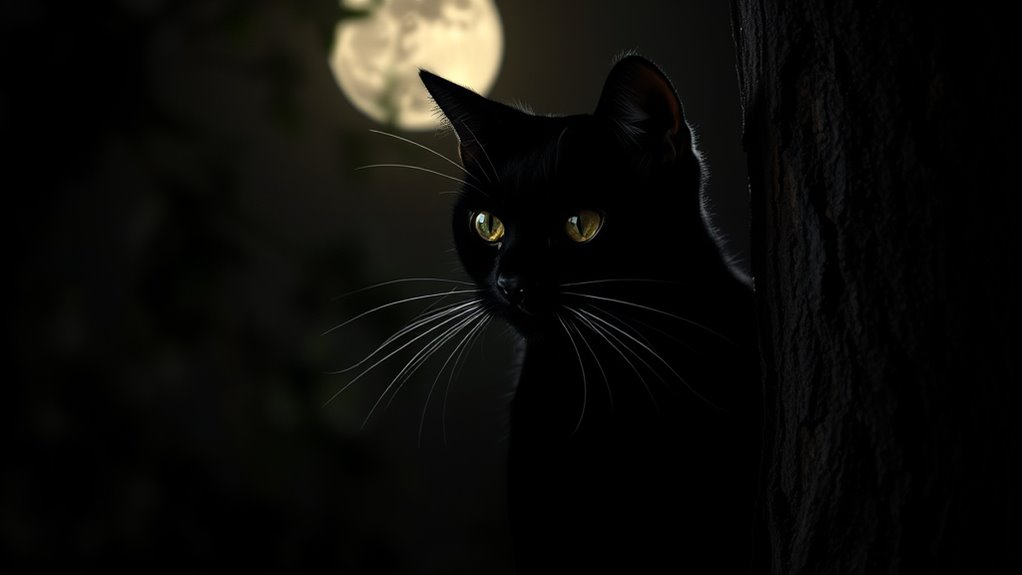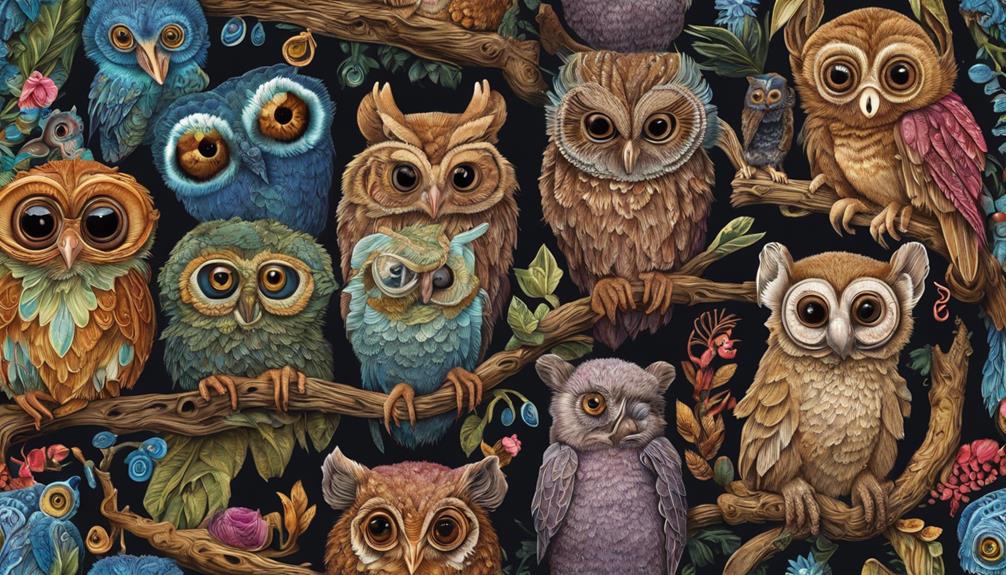Cat whiskers, or vibrissae, are your feline friend's secret weapons for hunting at night. They help detect nearby objects and prey, effectively guiding your cat through darkness. Whiskers provide real-time feedback on the size and shape of obstacles, preventing collisions as your cat stalks its target. Plus, these sensitive hairs can sense even the slightest movements in the air. If you want to learn more about how to keep those whiskers healthy, there's plenty more to discover.
Key Takeaways
- Whiskers provide critical sensory feedback, allowing cats to navigate their surroundings effectively in low light during nighttime hunts.
- These sensitive hairs detect minor movements, enhancing a cat's ability to identify prey even in complete darkness.
- Whiskers measure the cat's body width, helping them assess whether they can fit through tight spaces while stalking.
- Continuous scanning by whiskers enables quick adjustments in trajectory to avoid obstacles and improve hunting success.
- Whiskers also sense changes in air currents, helping cats detect nearby objects and potential prey even without visual cues.
Understanding Cat Whiskers
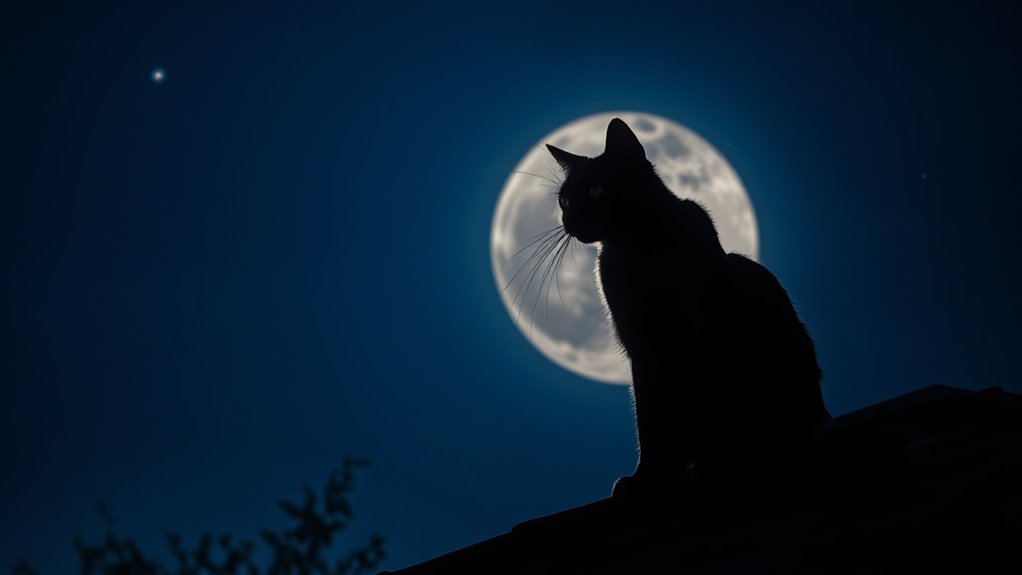
Whiskers are more than just a cute feature on your cat's face; they're essential tools for survival. These highly sensitive hairs, also known as vibrissae, are deeply embedded in your cat's body and provide critical sensory feedback about their surroundings, especially in low-light conditions.
They can detect even the slightest air currents, enhancing your cat's ability to navigate and hunt at night. Whiskers are roughly as wide as your cat's body, helping them gauge whether they can squeeze through tight spaces without needing to see.
The nerves at the base of each whisker relay important information about nearby objects' size, shape, and movement, which is crucial for their nocturnal hunting success. Whiskers continuously scan their environment, ensuring your cat's spatial awareness is sharp.
The Sensory Powerhouse of Whiskers

Cats possess a remarkable sensory tool in their whiskers, which play an essential role in their hunting prowess. These specialized hairs are equipped with tiny, sensitive nerves that detect even the slightest changes in the environment. This allows you to sense prey, even in low light. Whiskers can sense air currents, helping you navigate and locate food sources with pinpoint accuracy. As you move, they continuously scan your surroundings, preventing collisions and guaranteeing safety while stalking.
| Feature | Function | Impact |
|---|---|---|
| Sensitivity | Detects minor movements | Enhances hunting success |
| Air current detection | Guides navigation | Improves prey location |
| Size and shape perception | Identifies surrounding objects | Aids in strategic hunting |
| Continuous scanning | Prevents collisions | Guarantees safe stalking |
| Low light adaptation | Functions well in darkness | Maximizes nocturnal hunting skills |
Whiskers and Nighttime Navigation
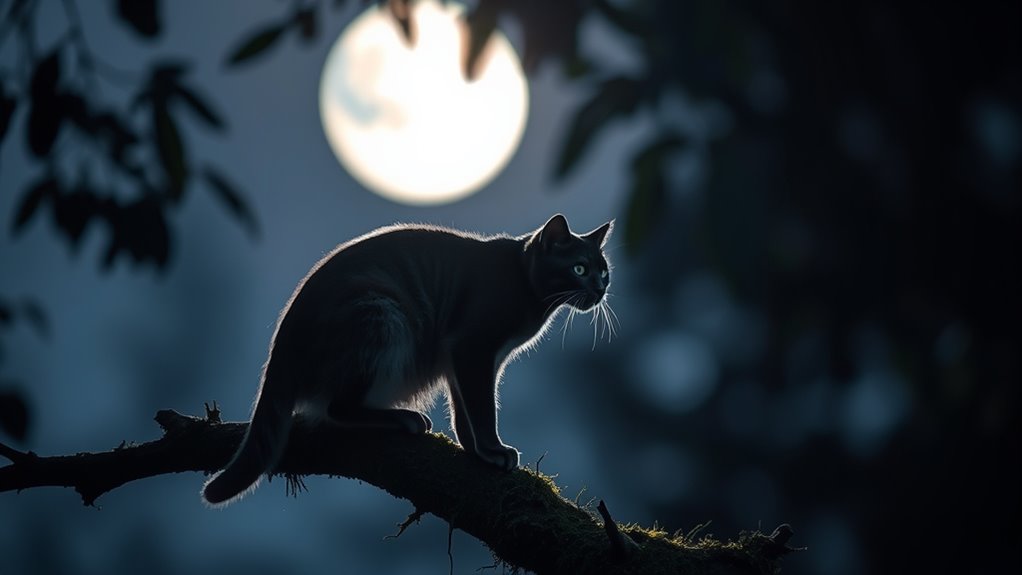
As you navigate the shadows of the night, your cat relies on its whiskers to expertly maneuver through the darkness. These highly sensitive structures detect subtle changes in the environment, enhancing its navigation skills.
The nerves at the base of the whiskers provide real-time feedback about nearby objects' size, shape, and speed, essential for spatial awareness in low light. As your cat moves, its whiskers constantly scan the surroundings, identifying obstacles and potential prey, which helps avoid collisions.
Since whiskers are roughly as wide as its body, your cat can gauge whether it can fit through tight spaces while stalking. Additionally, sensing air currents through its whiskers allows your cat to detect prey even in complete darkness, ensuring a successful hunt.
Detecting Prey in the Dark

When you watch your cat poised in the shadows, it's remarkable how effectively it detects prey in the dark. Their whiskers play an essential role in this ability, allowing them to sense even the slightest movements.
Here's how they do it:
- Whiskers are highly sensitive, detecting minute changes in air currents.
- They respond to the presence and direction of potential prey, even in complete darkness.
- The length of whiskers matches the cat's body width, helping gauge space for stealthy approaches.
- As your cat moves, its whiskers constantly scan the environment, gathering real-time data on nearby objects.
This combination of sensitivity and spatial awareness equips your cat to make precise movements, greatly increasing its chances of a successful nighttime hunt.
Preventing Collisions During Hunts

While stalking through the shadows, a cat relies on its whiskers to navigate tight spaces and prevent collisions during hunts. These sensitive structures gauge your body width, letting you glide through obstacles effortlessly. With nerves at their base detecting air currents, your whiskers provide real-time feedback about nearby objects.
Here's how whiskers enhance your hunting experience:
| Function | Description | Benefit |
|---|---|---|
| Body Width Gauge | Measures your width against surroundings | Prevents collisions |
| Air Current Detection | Senses changes in air around you | Detects nearby objects |
| Environment Scanning | Constantly checks surroundings | Avoids obstacles |
| Size and Shape Sensing | Evaluates objects' dimensions | Guarantees safe maneuvers |
| Trajectory Adjustment | Allows quick changes in direction | Improves hunting success |
Your whiskers make nighttime hunting a seamless experience.
Importance of Whisker Health
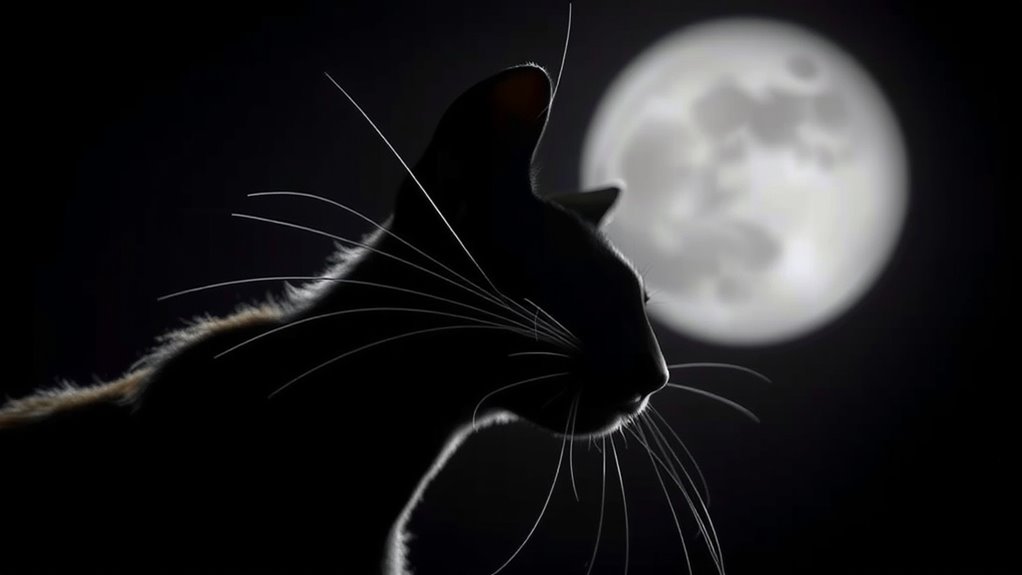
Your cat's whiskers are more than just cute features; they're essential sensory tools that need proper care.
If you notice any breakage or changes in their condition, it could signal underlying health issues.
Let's explore how to keep those whiskers healthy and what signs to watch for.
Whisker Care Essentials
Although whiskers might seem like mere facial adornments, they're essential for a cat's sensory perception and overall well-being.
Proper whisker care is important for your cat's health and comfort. Here are some essentials to keep in mind:
- Avoid trimming whiskers, as it can lead to disorientation and stress.
- Schedule regular veterinary check-ups to monitor whisker health and detect any issues.
- Provide a whisker-friendly environment by using wide, shallow bowls to prevent whisker fatigue.
- Keep an eye on the integrity of whiskers, as they play a significant role in navigation and hunting.
Signs of Whisker Issues
Whisker health directly impacts a cat's ability to navigate and hunt, making it crucial to recognize the signs of whisker issues. You might notice your cat refusing to eat or drink, which can indicate whisker fatigue from narrow bowls. Additionally, if your cat seems more agitated or restless, it could be a sign their whiskers are overstimulated or damaged. Regular vet check-ups are essential for evaluating whisker condition and overall health. To promote whisker health, create a whisker-friendly environment by providing wide, shallow bowls.
| Sign of Whisker Issue | Possible Cause |
|---|---|
| Refusal to eat or drink | Whisker fatigue |
| Increased agitation/restlessness | Whisker overstimulation |
| Visible breakage or loss | Underlying health issues |
Addressing Whisker Fatigue
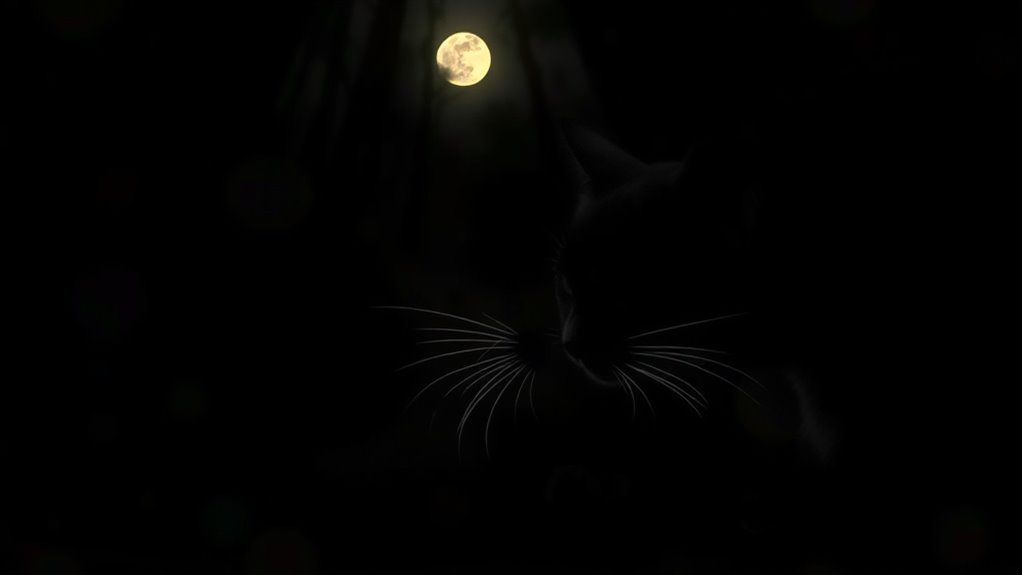
If you notice your cat avoiding their food or showing signs of stress during mealtime, it could be whisker fatigue.
Understanding the symptoms and making simple adjustments can greatly improve their eating experience.
Let's explore how you can provide relief and create a more comfortable feeding environment for your furry friend.
Understanding Whisker Fatigue
When your cat's sensitive whiskers brush against the sides of narrow bowls, it can lead to a condition known as whisker fatigue.
This discomfort can stress your cat during feeding times, affecting their overall well-being. To help your furry friend, consider these tips:
- Use wide, shallow bowls to prevent whisker contact.
- Make certain their feeding area is calm and quiet.
- Switch to different food textures that may be easier for them to manage.
- Monitor their behavior for any signs of distress during meals.
Symptoms to Recognize
Recognizing the symptoms of whisker fatigue can help you better support your cat during mealtime. Watch for key signs that indicate your cat's discomfort.
| Symptom | Description |
|---|---|
| Refusal to eat/drink | Your cat may avoid food or water altogether. |
| Stress-related behaviors | Look for agitation or acting out during meals. |
| Bowl preference | Notice if your cat struggles with deep or narrow bowls. |
These symptoms can lead to significant issues with hydration and nutrition. If you see these signs, it's crucial to observe your cat's feeding habits closely. By recognizing whisker fatigue, you can create a more comfortable eating environment for your feline friend.
Solutions for Relief
To effectively address whisker fatigue, you can make simple adjustments to your cat's feeding routine.
Here are some effective solutions to contemplate:
- Use wide, shallow bowls that prevent whiskers from touching the sides during mealtime.
- Create a calm feeding environment by reducing distractions, allowing your cat to eat peacefully.
- Rotate feeding locations to keep the experience fresh and stress-free for your cat.
- Schedule regular veterinary check-ups to identify any underlying health issues affecting your cat's whiskers.
Frequently Asked Questions
What Is the Main Function of Whiskers?
Whiskers serve a crucial function in helping you navigate your environment.
These sensitive hairs pick up on subtle changes, allowing you to gauge the size and shape of nearby objects. They're as wide as your body, which aids in maneuvering through tight spaces.
Does a Cat Use Its Whiskers for Hunting?
Imagine you're a cat stalking through the shadows, your whiskers twitching as you sense every movement.
Yes, you do use your whiskers for hunting! These sensitive hairs help you detect changes in your environment, allowing you to pinpoint prey even in dim light.
For instance, when a mouse scurries nearby, your whiskers pick up the slightest air currents, guiding you silently towards your next meal.
They're essential for your stealth and precision while hunting.
Why Do Deer Have Whiskers?
Deer have whiskers to enhance their sensory perception in various ways.
These sensitive vibrissae help you detect changes in air currents, alerting you to nearby predators or threats. They also assist in maneuvering through dense vegetation, allowing you to avoid obstacles easily.
Additionally, your whiskers provide tactile feedback, helping you gauge the width of openings and even aid in social interactions with other deer by sensing their proximity.
What Are the Whiskers Above Cat's Eyes For?
Did you know that cats have around 24 whiskers on their face?
The whiskers above your cat's eyes, known as supraorbital whiskers, play a critical role in enhancing their sensory perception.
These whiskers help your cat gauge distances and detect nearby objects, making it easier for them to navigate their surroundings.
They're highly sensitive, allowing your feline friend to respond quickly to changes in their environment, ensuring safe and stealthy movement.
Conclusion
As you watch your cat stealthily navigate the shadows, those delicate whiskers are more than just cute—they're lifelines. Each twitch and bend helps your feline friend dance through the darkness, sensing the slightest movements of potential prey. Imagine the thrill of a successful hunt, guided by those sensory marvels. By ensuring your cat's whiskers are healthy and free from fatigue, you're not just caring for them; you're nurturing their instinctual prowess, celebrating their wild, nocturnal spirit.
